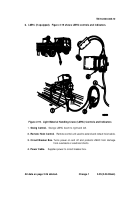TM-9-2320-365-10 - Page 119 of 836
TM 9-2320-365-10
(5) Not Fully Mission Capable If: Column. This column tells you what faults will keep
your vehicle from being capable of performing the primary mission. If you perform check
and service procedures that show faults listed in this column, do not operate the vehicle.
Follow standard operating procedures for maintaining the vehicle or reporting equipment
failure.
d. Other Table Entries.
Be sure to observe all special information and notes that
appear in the table.
e. Shortened Intervals.
Shorten intervals if operating the equipment under adverse
conditions, including longer than usual operating hours. An asterisk will come before the
Interval. A footnote will explain the asterisk and the reason for the shortened Interval.
f. Weekly Intervals.
When a Check/Service procedure is required for both WEEKLY
and BEFORE Intervals, you do not have to perform the procedure twice if the vehicle has
been operated during the week.
g. Leakage Criteria.
Leakage Criteria is included in the "Not Fully Mission Capable If:"
Column.
2-13. GENERAL MAINTENANCE INSTRUCTIONS
WARNING
Adhesives, solvents, and sealing compounds can burn easily, can
give off harmful vapors, and are harmful to skin and clothing. Keep
away from open fire and use in well-ventilated area. If adhesive,
solvent, or sealing compound gets on skin or clothing, wash
immediately with soap and water. Failure to comply may result in
serious injury or death to personnel.
a. Cleanliness.
Dirt, grease, oil, and debris only get in the way and may cover up a
serious problem. Use Dry Cleaning Solvent (Item 15, Appendix D) on metal surfaces
where directed.
b. Bolts, Nuts, and Screws.
Check bolts, nuts, and screws for obvious looseness, and
missing, bent, or broken conditions. Look for chipped paint, bare metal, or rust around bolt
heads. If any part seems loose, tighten it or notify Unit Maintenance.
c. Welds.
Look for loose or chipped paint, rust, or gaps where parts are welded
together. If a bad weld is found, notify Unit Maintenance.
d. Electrical Wires and Connections.
Look for cracked or broken insulation, bare
wires, and loose or broken connectors. Tighten loose connectors and make sure wires are
in good shape. If a bad wire or connector is found, notify Unit Maintenance.
2-31
Back to Top




















